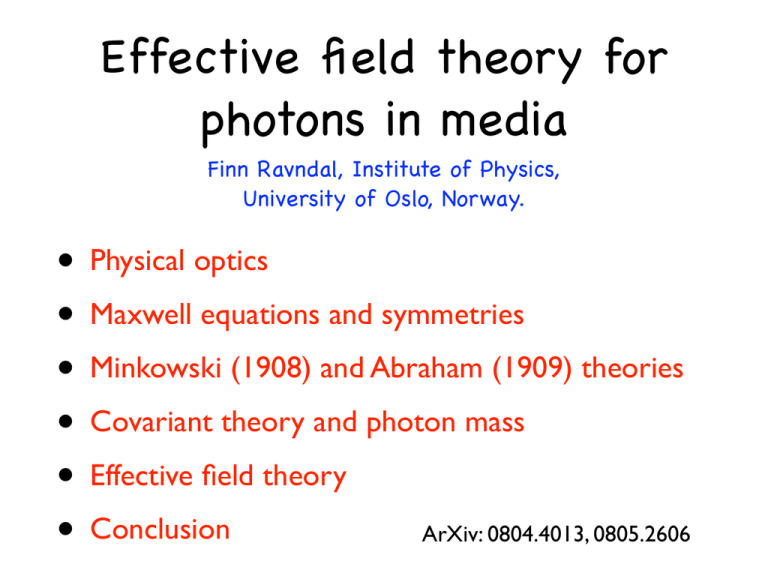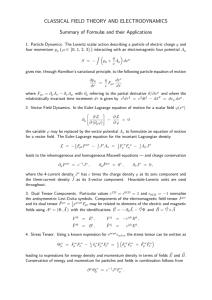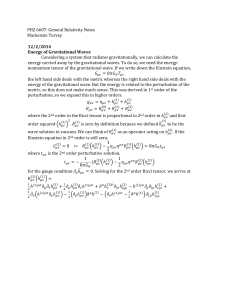• Effective field theory for photons in media
advertisement

Effective field theory for
photons in media
Finn Ravndal, Institute of Physics,
University of Oslo, Norway.
• Physical optics
• Maxwell equations and symmetries
• Minkowski (1908) and Abraham (1909) theories
• Covariant theory and photon mass
• Effective field theory
ArXiv: 0804.4013, 0805.2606
• Conclusion
Refraction:
sin θ0 = n sin θ
• In vacuum:
•ν λ =c ≡1
0 0
0
•
• In medium:
!0
"0
n=1
n>1
"
νλ = c = ν0 · λ0 /n = 1/n
!
Light wave going through
a material medium:
!
A(x, t) =
1 "
Ak (t)eik·x
V k
!0
(1)
!
P
Figure 1: Photon with wavevector k being emitted in the xz-plane. Initial atomic spin is along the
z-axis.
for eneach
3-dimensjonal
harmonisk
oscillator er in the forward
ScatteredHamilton-operatoren
waves from
atom
interfere
1
1
# +with
p
mω #r shorter wavelength.
=
direction to give a newH#wave
2m
2
2
2 2
Maxwell equations:
∂B
∇×E+
= 0,
∂t
∂D
∇×H−
= 0,
∂t
∇·B=0
∇·D=0
Constitutive relations:
Gives wave equation
with
n=
√
εµ
B = µH
D = εE
!
2
∂
2
n
−
∇
E(r, t) = 0
2
∂t
2
"
efields
atoms
the
while H describes
the similar
modification
E in
and
B material,
be the components
of the standard
antisymmetric
tensor
+ ∂ν Fλµ + ∂µ Fνλ = 0
λ Fµν
field B due
to magnetization of∂the
atoms.
"
!
"
!
0 −E
−E
0 varying
eral
local
fields
on
the
microscopic
scale
between
µν
µν rapidly
here the covariant
gradient
operator
has
the
components
∂µ = (∂
F =
(3)
F
=
E
−B
is scale we expect ordinary ijLorentz invariance to be valid.
Indeed,
E −B
ij
mbining
D
and
H
into
the
corresponding
antisymmetric
tensor
erified by writing these four equations on covariant form. For that
Bij = εijk Bk . Then we can write the first two Maxwell equations (1)
" the first two Ma
! we antisymmetric
when
write
Bij = in
εijkof
Bthe
can write
fields EMaxwell
and B we
be the
components
standard
k . Then
equations
rest
frame:
Covariant formulation
as
∂λ Fµν + ∂ν !
Fλµ + ∂µ Fνλ
H
"0
=
µν
=
0 −D
D −Hij
(4)
0 −E
F =
(3)= 0
∂
F
+
∂
F
+
∂
F
λ
µν
ν
λµ
µ
νλ
iant gradient operator has
the
components
∂
=
(∂
,
∇).
Similarly,
E −Bij
µ
t
µν
th
two last equations
(2) become simplified to
ij =
ijk Hk , the antisymmetric
d HH
into
theεcorresponding
tensor
e=
taken
to. be
constants.
These
constitutive
relations
now
represent
an effect
where
the
covariant
gradient
operator
has
the
components
∂µ =
"
!
ε
B
Then
we
can
write
the
first
two
Maxwell
equations
(1)
j
ijk k
−D medium
0 and
iption ofcombining
the
fields
in
the
where
microscopic
variations are averag
µν
µν
D
H into the
corresponding
antisymmetric
tens
(5)
H =
∂
H
=
0
ν
D −Hij
n some sense.
"
!
∂ F
+∂ F
+∂ F
=0
(4)
to
theseshown
field
e relations
can
also
be
formulated
in
an
arbitrary
frame
as
already
√
V
=
Boost velocity:
D Similarly,
−Hij
2 (∂ , ∇).
µν
ant
gradient
operator
has
the
components
∂
=
1
−
v
µ
t
peared
on
the
right
hand
side
of
this
equation.
owski[2]. Let the∂νmedium
with correspon
H = 0 move with velocity v and therefore
(6)
H into the corresponding
our-velocity
V µ = γ(1, v).antisymmetric
Here γ = (1tensor
− v 2 )−1/2 as follows from V µ V =
λ µν
ν λµ
νλ
−D
0coupled
µ(1, µν
Hk , the
last equations
(2) µbecome
simplified
to
v)
ad
we two
included
a four-current
J
=
(ρ,
J)
µ
H =
µ = εijk Hk , the two last equations (2) become
with
H
ij
d a four-current
J
=
(ρ, J) coupled
to these fields, it would have
"
!
µ Covariant
µν
form
of
constitutive
eqations:
the
rest
frame
of
the
medium
are related by
ing
F hand
= FsideVofν ,this
oneequation.
can−D
then write the fields
0
right
µν
µ
simplified
D = εE
(5) the magneti
H = Both the electric permittivity
µν
tropic matter.
ε
and
∂
H
=
0
D −Hij
ν
2
µHfields
Fµν
+ (nby
−D1)(F
Fν=VµH
µν =are
µ Vand
ν −B
µ ) for
e of the medium the
related
= εE
. Both
the
electric permittivity ε and the magnetic µpermeability µ
the two
2 last equations (2) become simplified to
k,
µHµν = Fµν + (n − 1)(Fµ Vν − Fν Vµ )
n2 = εµ. Several years later Gordon[13] rewrote this on the more su
2
ere
now
n
= εµ. Several
years later Gordon[13] rewrote this on the
µ
µν
m
F = F Vν
with
tive form
ρ
σ
µH
=
X
X
(
µν
µ
ν Fρσ
µ
ρ
σ
we write
A
=
(Φ,
A).
µH
=
X
X
Can then write
µν
µ
ν Fρσ
ducing the tensor
an
derive thethe
wave
equation from a variational principle. The Lagrangian
er also
introducing
tensor
from with
the requirement
theory
Xµν that
= ηµνthe+vacuum
(n2 − 1)V
µ Vν should result in the limit n → (1
2
Hµν → Fµν . It then becomes
the
simplest
Xµνclear
= ηthat
+
(n
− 1)Vµ Vchoice
µν
ν
2
2
erm ∝ (n − 1) in (7) will not contribute because of the antisymmetry
1
2
2
µν contribute because of the antisy
eηµν
lastisLagrangian:
term
∝
(n
−
1)
in
(7)
will
not
the Minkowski metric
that
Xµν plays the role of a generaliz
L = −so
Fµν
H
(13
4metric so that X plays the role of a
.
Here
η
is
the
Minkowski
σ
µν
µν
etric[14].
desired properties. In
and magnetic vector fields i
1 termsµνof ρthe electric
σ
es
L =or
(E
DµL
−B
H)/2
when
inserting
the tensors
(3) and
(5). Using
X
F
X
=· −
o find
an · equation
ofFmotion
of
the
one must
combine
the th
tw
ρσ
ν field,
µ
4 frame of the medium, it is
utive
relations
in
the
rest
order to equations
find an equation
of motion
of the
field, one
combin
Maxwell
(4) and (6).
The first
is satisfied
as must
an identity
variant
Maxwellpotential
equations
and
(6).
an t
g a four-vector
Aµ1(4)
so2that
Fµν
∂µ Afirst
then
ν − ∂is
ν Asatisfied
µ . Using as
2
2 =The
µL =
(n E are
−
) symmetry
(14
µ Bnot
But
Lorentz
boosts
e relation a(7)
in the second
equation
the corresponding
roducing
four-vector
potential
A (6),
so that
Fµν = ∂µ Aν −wave
∂ν Aµequati
. Usin
2
. It takes
the
form
when
chooses
gauge
equivalent
to
t
nstitutive
relation
(7) instead
intransformations!
the second
equation
(6),arelations
the
corresponding
wav
eneral
frame
onesimplest
must
use
theone
constitutive
on the covarian
uge
in vacuum,
i.e.the
ows[15].
It takes
simplest
form of
when
one chooses
a gauge
equiva
7).
The
Lagrangian
is then
a function
the 4-vector
potential
Aµ , but
wil
epend
explicitly
on the µfour-velocity
Vµµ of the νmedium. It is therefore no
renz gauge
i.e. 2
µν in vacuum,
Symmetries
Lorentz transformations
• Invariance underspeed
of light c=1/n
with reduced
• Gauge invariance:
B = ∇ × A and
E = −∂A/∂t − ∇Φ invariant under
A → A + ∇χ
Φ → Φ − ∂χ/∂t
Massless photons ?
Energy density
and conservation:
where N = E × H
Momentum density
and conservation
where
"
1!
E = E·D+B·H
2
∂E
+∇·N=0
∂t
is the Poynting vector
G=D×B
∂G
+∇·T=0
∂t
1
Tij = −(Ei Dj + Bi Hj ) + δij (E · D + B · H)
2
is the Maxwell stress tensor
1 µν
µνµ
αβ
µ
αν
η
F
H
T
=
F
H
+
x = (t,αx) can combineαβ
With M
to 4-dimensional
4
µν
conservation
∂ν T
can be
displayedlawin the
matrix
M =0
µν
TM
T
00
=
!
E N
G Tij
where
"
isis the
energy density
the Minkowski
energy-momentum tensor
1
E
=
(E
·
D
+
B
·
H)
Tensor only symmetric
in vacuum where G = N
2
the components of the Poynting vector N = E ×
on-symmetric with the components T k0 forming th
nally, the space-space components make up the ten
split
up Minkowski
the Minkowski
tensor
(16)
twoterms,
terms,
up the
tensor
(16)
inintwo
up the Minkowski tensor (16) in two
! terms,
"
e first part
Abraham
(1909):
!
0
µν
µν
2
"
0
! 0 0"
T
=
T
+
(n
−
1)
µν M µν A
2
TMµν = TAµν + (n2 − 1) 0 N 0 0
TM = TA + (n − 1)
N
0
N 0
tt part
tensor
"
!
partwhere symmetric energy-momentum
E N"
!
!
= E N "
NNTij
E
=
=
TAµν
µν
µν
T
A
TA(22)
N T
Tij
N
ij
braham tensor[3]. It is symmetric by construction. From the
µν
lawtensor[3].
for
the
the
Minkowski
tensor
onconstruction.
the second index,
it follo
m
It
is
symmetric
by
From
the
=
0
∂
T
Conservation
gives
ν
n. From
the above
am
tensor[3].
It isconsymmetric
by construction. From the
M
µν
tensor
is not
generally tensor
conserved.
Instead,
it index,
satisfiesit∂νfollo
TA
for
the
the
Minkowski
on
the
second
it follows
that the tensor on the second index,
for the
the Minkowski
it folloµ
µndex,
µ
is is
a force
density.µ Inconserved.
the rest frame
we see that
K = (0,
K)
µν
µν
sor
not
generally
Instead,
it
satisfies
∂
T
atisfies
∂
T
+
K
=
0
where
Abraham
force
ν
ν
sor is notAgenerally conserved. Instead, it satisfies ∂ν TAA
µ
µµ = (0, K)
K
=
(0,
K)
where
force
density.
In
the
rest
frame
we
see
that
K
a force density. In the rest
∂ we see that K = (0, K)
2 frame
K = (n − 1) (E × H)
∂t
∂∂
(23)2
Quantization
Photon energy:
E = h̄ω
Photon momentum: p = h̄k = nE
from Minkowski momentum density G = D × B
and
p = h̄k/n2 from Abraham momentum density
N = E × H = G/n
2
Photon mass:
m2γ
Minkowski
1 − 1/n > 0 Abraham
2
<0
1
−
n
=E −p =E ·
2
2
2
2
{
Effective Theory
Light cone in medium rest frame: x = ±t/n
Metric:
2
2
2
2
ds = dt /n − dx = ηµν dx dx
µ
= (t/n, x) or ∂µ = (n∂t , ∇)
x
with
µ
ν
so that covariant 4-momentum p = (nE, p)
µ
Massless excitation p pµ = 0
µ
as for Minkowski photon.
or E = p/n
not invariant under the corresponding transformations.
munder
itself the
is not
invariant under
the corresponding transformations
corresponding
transformations.
mmagnetism
is in thisisrespect
different
since
the
vacuum
is
invariant
in this respect different since the vacuum is invarian
µ
pect
different
the vacuum is invariant
eansformations.
write
A =since
(Φ, A).
Lorentz transformations.
Covariant
also
the
wave
equation
from
athe
variational
princ
electromagnetism
ke
this derive
material
symmetry
manifest,
introduce
the
correspondin
aterial
symmetry
manifest,
introduce
corresponding
try manifest, introduce the corresponding
µ
µ
nate
four-vector
x
so vacuum
that
=
th
rom
the
requirement
that
the
theory
should
res
t , ∇).
-vector x = (t/n,=x)(t/n,
so x)
that
∂µ =∂µ(n∂
, ∇).
ForForthe
t(n∂
(t/n,the
x)
so
that
∂
(n∂
the
µ = potential
t ,µ∇).Aµ For
form
new
four-vector
=
(nΦ,
A).
The
electric
an
4-vector
potential
→
F
.
It
then
becomes
clear
that
the
simplest
cho
new
four-vector
potential
A
=
(nΦ,
A).
The
electric
and
µν
µν
µ
r potential
= (nΦ,
A).
The electrictensor
and Fµν = ∂µ Aν −∂ν A
ectors
are stillAgiven
by the
antisymmetric
still given by the antisymmetric tensor Fµν = ∂µ Aν −∂ν Aµ
he
tensor Fµν = ∂µ A1ν −∂ν Aµµν
he antisymmetric
components
and field tensor
L
=
−
F
H
µν
!
" 4
0 "−nE
! µν
or" F 0 = −nE
(24
desired
terms
of the electric and (24)
mag
nE In−B
ij
−nE
F µν = properties.
(24) the tensors (3
nE
−B
ij
s
L
=
(E
·
D
−
B
·
H)/2
when
inserting
E −Bij
1
µν takes the standar
n termsLagrangian:
of this, the rest-frame
Lagrangian
(14)
F
F
µL
=
−
µν
tive
relations
in
the
rest
frame
of
the
medium,
it istrans
2
4
/4)F
.
It
is
now
explicitly
invariant
under
material
Lorentz
µν the rest-frame Lagrangian (14) takes the standard
f-frame
this,
Lagrangian (14) takes the standard
first
setexplicitly
of field equations
(4) under
obviously
remainsLorentz
unchanged
whil
1
is
now
invariant
material
trans2 trans2
2
tly
invariant
under
material
Lorentz
µν
− Bwe) make use of th
well equation (6) is replacedµL
by =
∂µ F (n=E
0 when
of field
equationsremains
(4) obviously
remains
unchanged
while
2
ons
(4)
obviously
unchanged
2 while
ν
ν
ations. Writing this out, it becomes ∂ A = ∂ (∂ · A) where now
nents
µν
now also find a satisfactory energy-momentum tensor fro
n (21)Standard
appropriate
to this
Itαβgives
1group.
µν
µν new µLorentz
αν
energy-momentum
tensor
µT = F α F + η Fαβ F
4
1 µν
αβ
µν
µ
αν
η
F
F
µT
=
F
F
+
αβ
α
ith components
4
onents
with components
T
!
µν
=
!
E nN
nN" Tij
"
E nN
T =
is now symmetric
and
conserved
both indices
is obviously
symmetric,
traceless
conserved
on both in
nN and
Tij on
T νµ = 0. ∂InT the
direction
this gives energy conservati
µν time µν
=
∂
T
=
0
ν
µ
hile
the space directions
gives
momentum
conservation
uslyinsymmetric,
traceless it
and
conserved
on both
indices,
∂E
entum
density
of
the
D × energy
B is therefore
the same
+ ∇field
· N this
=G0 =gives
. In the
time direction
conservation
on
giving
∂t
heeory.
space directions it gives momentum conservation as in
∂G
Minkowskithe
momentum
ensity and
of the field +
G∇=· TD=×0 B i.e.
is therefore
same as in
he rest frames of∂tthese systems are preferred frames. It is also
density! For the electromagn
ost natural to quantize the excitations.
µν
Physical consequences:
!
1!
h̄|k|
h̄ωk =
n
1) Casimir effect: E0 =
k
k
1 vac
i.e. E0 = E0
n
I. Brevik and K. Milton, arXiv 0802.2542
! 3
h̄ωk
d k
2) Thermal radiation: U =
(2π)3 eβh̄ωk − 1
i.e.
U = n3 Uvac ∝ n3 T 4
Landau & Lifschitz, 1960
ItItisisequivalent
equivalent to
to EE· ·∇
∇ EE by
by aa partial
partial integration
integration in
in the
the action
action integral whe
appears.
appears. The
Thesimilar
similar term
term ∂∂ttEE··∂∂ttEE involving
involving two
two time
time derivatives
derivatives is for the s
reason
reasonequivalent
equivalent to
to EE··∇
∇22EE when
when we
we use
use the
the equation
equation of
of motion.
motion. An interac
likeEE· ·∇∇22BBisisruled
ruledout
out by
by parity
parity invariance.
invariance.
like
Interactions
dielectricmaterials
materialsmagnetic
magnetic effects
effects are
are negligible,
negligible, and
and it
it is
is therefore
therefore reason
InIndielectric
assumethat
thatall
allthe
theterms
termsinvolving
involving the
the magnetic
magnetic field,
field, can
can be
be dropped.
dropped. Inclu
totoassume
µ
=
1
:
Dielectric
has
interactionterms
termsup
upto
todimension-8
dimension-8operators,
operators, we
we then
then have
have the
the effective
effective Lagran
interaction
""
εε!! 212
dd22 22 22
aa
dd11
2
2
22
22
2 µν
2
L
=
E
−
B
/n
+
E
·
∇
E
+
(∇
E)
+
(E
L
=
E
−
B
/n
+
E
·
∇
E
+
(∇
E)
+
(E
·
E)
Lef f =
M22
M44
M44
22 − 4 Fµν F
M
M
M
Theparameter
parameterM
M isisan
anenergy
energyscale
scale which
which characterizes
characterizes the
the microscopic
microscopic physic
The
dispersion
havedescribes
integratedout.
out.
In aa dielectric
dielectric this
this isis set
set by
by atomic
atomic physics
physics and
and should ha
have
integrated
In
valuearound
around 55 -- 10
10 eV.
eV. ItIt isis possible
possible
to calculate
calculate
or at
at least
least estimate
estimate the dim
B2
B1to
value
or
B1,2physics
∝ d1,2
+from
n(λ) =
sionless coupling
coupling constants
constants
, dd2+
and
a
from
the
atomic
of the mate
2
4
sionless
dd11,A
a
the
atomic
physics
2 and
λ
λ
Withaarealistic
realistic value
value for
for the
the energy
energy scale
scale M
M,, the
the Lagrangian
Lagrangian contains
contains only t
With
independent
parameters.
For each
each material
material they
they can
can therefore
therefore be
be determined
and theparameters.
Kerr effect
independent
For
threedifferent
differentmeasurements.
measurements. ItItwould
would then
then be
be able
able to
to predict
predict the
the outcome
outcome of m
three
2
∝
a dominated
n(E)
=n+
otherexperiments.
experiments. In
In practice,
practice,
weKE
expect the
the term
term ∝
∝K
to be
be
dominated by
other
we
expect
dd22 to
-term.
dd1 1-term.
M = (5term
− 10)eV
LetCharacteristic
usfirst
firstconsider
considerthe
themass:
effectof
ofthe
thedispersive
dispersive
term
∝ dd11 in
in the
the effective
effective Lagrang
Lagrang
Let
us
effect
∝
It gives a contribution to the classical equation of motion for the field that is lin
Conclusion
• Electromagnetic field in medium is like any
other excitation in condensed matter
physics, theory defined in rest frame only
• Theory similar to Minkowski formulations
in most physical predictions
• Effective theory describes dispersion in a
natural way
• Quantum corrections can be calculated






